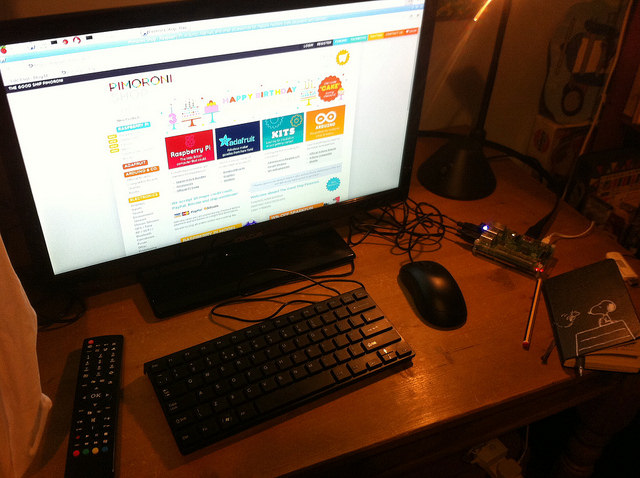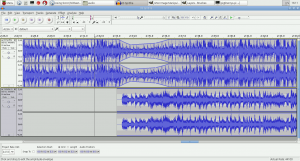
We’re now a FOUR Pi household. One Raspberry Pi is our wireless print server, enabling us to use an old cheap laser printer to print from Macs, Raspberry Pis, iPhones and iPads; another is our kitchen radio; the third is for my tinkering.
Enter our 4th Pi. It’s a brand new improved RaspberryPi model 2 I bought for Son A. It now boasts a quad core processor (I’m guessing that’s why you see 4 raspberries when it boots) and is generally regarded as being 6 times more powerful / faster / tastier. And yet it still costs just £30, less keyboard, mouse, case, screen, wifi dongle and SD card. Adding all of those things except the screen cost about £85 bundled from Pimoroni, though you could do it more cheaply, especially if you have a keyboard, mouse and power supply spare. The monitor is a supermarket TV that cost about £120, but again you could save money here.
We got a full starter kit with a lovely cool blue Flotilla Pibow Coupe case from the people on the good ship Pimoroni. And I’m very envious. It runs and boots darn quickly, and seems quite happy with a web browser and other applications open at the same time.
I’ve found that the audio editor Audacity seems to work pretty well (I did over-clock the Pi). There’s a small delay when playing audio over HDMI, but the audio does play in-sync. Next I’ll try analogue audio playback and also try my Griffin iMic USB audio adaptor for playback and capture. This could a great tool for school radio stations, or just teaching audio editing and making podcasts. I’ll be doing some more work on this, and looking at possible playout solutions. CoolPlay for Linux, anyone?
It will play YouTube videos back in the browser, at least at standard definition, the graphical desktop is much, much faster than previous Pis, to the point where you could use this as a general computer. Son A installed GIMP for photo editing and Open Office for word processing, and I just installed CUPS so he can print his homework on the colour inkjet plugged into our iMac or the old Brother laser printer plugged into the Pi print server. I didn’t even need to configure it, it just found the printers on our home network. Flickr is perfectly usable on the default Raspbian web browser (‘Web’) and I’m happily writing this blog post on the Pi2 too. A hell of a useful tiny computer for a school, or kid’s bedroom at only £30 (around £200 including a TV and all the bits) – and it’ll save squabbling over access to the family iMac.
Son A has a cheap Sainsbury’s 22 inch Celcus LED22167FHD TV in his room and we got the picture filling the screen nicely with these settings in /boot/config.txt:
# uncomment this if your display has a black border of unused pixels visible
# and your display can output without overscan
disable_overscan=0
# uncomment the following to adjust overscan. Use positive numbers if console
# goes off screen, and negative if there is too much border
overscan_left=10
overscan_right=10
overscan_top=-17
overscan_bottom=-17
Now I want a Pi2 of my own. Can I justify becoming a FIVE Pi household?
The Raspberry Pi has certainly come a very, very long way in 3 years. Here’s what the desktop looked like back in 2012 when I got my first Pi (still going strong).

